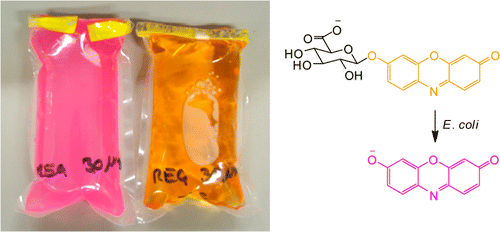
Germinal Magro, Robert E. S. Bain, Claire A. Woodall, Robert L. Matthews, Stephen W. Gundry and Anthony P. Davis*
Environ. Sci. Technol. 2014, 48, 9624–9631
This article was covered in a news article by Access Science.
Abstract
The development of low-cost tests for Escherichia coli is hampered by the expense and limited choice of enzyme substrates. Most chromogenic substrates are required in costly amounts, while fluorogenic substrates require an additional apparatus (e.g., an ultraviolet lamp) to be detected. Herein, we propose an alternative chromogenic substrate, resorufin β-d-glucuronide (REG), which is exceptionally sensitive and may be employed in very small amounts. We show that REG can be produced similarly to other simple glucuronides and should therefore be no more expensive. The compound is used by both healthy and injured E. coli, resulting in a pronounced color change from orange to a bright pink. Because the released dye (resorufin) has a high extinction coefficient, substantially lower amounts are needed than for commercially available substrates. The potential of this substrate is demonstrated by a presence/absence test requiring just 0.1 mg of REG/100 mL of water sample, one hundredth of the quantity needed for common chromogenic substrates, with an estimated bulk cost of ≤0.1 U.S. cents/test. REG shows promise as a chromogenic substrate for E. coli detection and should be considered in the development of new water tests, especially for low-income settings.